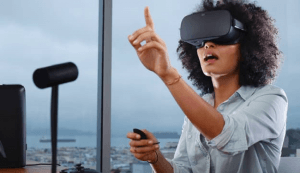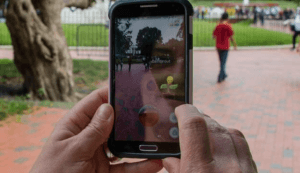


Mối quan hệ giữa thực tế ảo và ứng dụng tương tác thực tế



Samira Kabbour
CMO
Mục lục
Chúng ta sẽ sớm có thể chọn cách chúng ta nhìn thực tế cuộc sống theo cách chúng ta thay đổi hình ảnh trên màn hình điện thoại thông minh.
Thực tế ảo (Virtual Reality)
Thực tế ảo là một công nghệ cho phép người dùng trải nghiệm một thực tế theo một cách khác với thực tế, bằng cách tạo ra ảo ảnh thay thế môi trường mà anh ta nhìn thấy và thỉng thoảng khi nghe và cảm nhận, trong một môi trường khác. Một ví dụ điển hình là kính thực tế ảo như Gear VR, Day Dream, Oculus Go, Mirage Solo, HTC Vive… hoặc thậm chí Google Cardboard được làm bằng bìa cứng và một cặp ống kính. Kính thực tế ảo thường bao gồm màn hình hoặc khả năng kết nối điện thoại thông minh như một màn hình và ống kính thông qua đó chúng ta có thể nhìn thấy. Vì vậy người xem có thể nhìn thấy môi trường được chiếu thay vì môi trường thực.
Công nghệ tích hợp (Augmented Reality)
Không giống như thực tế ảo, công nghệ thực tế còn gọi là công nghệ tích hợp làm thay đổi như thế giới thực có thể nhìn thấy mà không cần thay thế hoàn toàn. Nói cách khác, thông tin ảo có thể được thêm vào môi trường vật lý hoặc đến một vị trí cụ thể trong không gian.
Nói cách khác, thông tin ảo có thể được thêm vào môi trường vật lý hoặc đến một vị trí cụ thể trong không gian. Ví dụ như bạn có thể xem qua màn hình điện thoại trong phòng bạn đang ở và đặt trong phòng nội thất mà bạn muốn mua. Ngoài ra, bạn có thể đo chiều dài, chiều rộng và chiều cao của bàn trong phòng. Một ví dụ khác là khả năng “đo” quần áo trước khi mua, và sau đó đặt chúng lên người bạn và theo kích thước vóc dáng của bạn.
Vào những năm 1960, Morton Hailig đã xây dựng Sensama, một loại hình nhà hát thực tế ảo cho phép người xem có thể xem nnăm bộ phim ngắn bao gồm trải nghiệm đa giác quan: thị giác, thính giác, khứu giác và xúc giác. Một thời gian sau đó, vào năm 1968, Ivan Sutherland và Bob Sprawl đã chế tạo “Sword of Damocles”, một thiết bị bao gồm hai màn hình tivi treo trên trần nhà phía trên đầu của người dùng (do đó là tên) và đặt trước mắt anh ta. Do đó, đó là lần đầu tiên kính thực tế ảo đã được tạo ra.


Một cách dùng phổ biến của thực tế ảo là được sử dụng trong các trò chơi và phim trên máy tính.
Trong nửa đầu thập niên 1990, một số phiên bản kính thực tế ảo đã được phát hành cho các trò chơi, chẳng hạn như SEGA VR-1hoặc Nintendo Virtual Boy, nhưng kết quả không khả quan.
Trong thập kỷ qua, một dòng các thế hệ thiết bị mới như Oculus Rift, HTC Vive, PlayStation VR và nhiều hơn nữa đã được phát triển, mang đến nhiều ứng dụng và các ứng dụng mới trong lĩnh vực này, như đào tạo mô phỏng cho các nhiệm vụ nhạy cảm hoặc phức tạp như thủ tục y tế, huấn luyện quân sự hoặc huấn luyện trên không.
Công dụng quen thuộc nhất của thực tế mới được phát hiện là trò chơi Pokémon Go, nhằm mục đích định vị và bắt Pokemon “lang thang” trong thế giới thực. Trò chơi, được phát hành vào tháng 7 năm 2016, đã thu hút hơn 800 triệu lượt người dùng tải xuống trong vòng chưa đầy hai năm!


Một cách dùng thực tế hơn trong cuộc sống hàng ngày là nhiệm vụ điều hướng. Các lĩnh vực của thực tế ảo đã trở thành một đấu trường cạnh tranh giữa những khổng lồ về công nghệ. Facebook mua lại Oculus VR vào đầu năm 2014 và phát triển Facebook Spaces, một nơi dành cho các cuộc họp tương tác trong môi trường ảo.
Ngoài ra, Google đang làm việc trên DayDream và gần đây đã hợp tác với Lenovo để tạo ra Mirage Solo, AR / VR với màn hình tích hợp. AT & T đã đầu tư vào Magic Leap năm nay, một công ty khởi nghiệp sản xuất kính nhiều lớp sáng tạo tích hợp đồ họa máy tính và ký thỏa thuận hợp tác và độc quyền tại thị trường tiêu dùng Mỹ, kết hợp công nghệ này với cổng thông tin 5G.
Công nghệ đang phát triển nhanh chóng và các thiết bị tiên tiến hơn đang gia nhập vào thị trường. Theo đánh giá trong vài năm tới, chúng ta có thể sử dụng trải nghiệm thực tế ảo cho các công việc hàng ngày diễn ra bên ngoài, chẳng hạn như đi làm, mua sắm, gặp gỡ bạn bè và tất cả có thể diễn ra trong một môi trường ảo.
Nếu vậy, câu hỏi được đặt ra là liệu chúng ta liệu sẽ sớm có thể chọn thực tế cuộc sống của chúng ta dễ dàng như chúng ta thay đổi các bức tranh trên màn hình điện thoại thông minh của chúng ta không? Mô phỏng hoặc nhiều lớp– Nó thì khá rõ ràng trong những năm tới, thực tế cuộc sống của chúng ta sẽ thay đổi mà không được công nhận.



